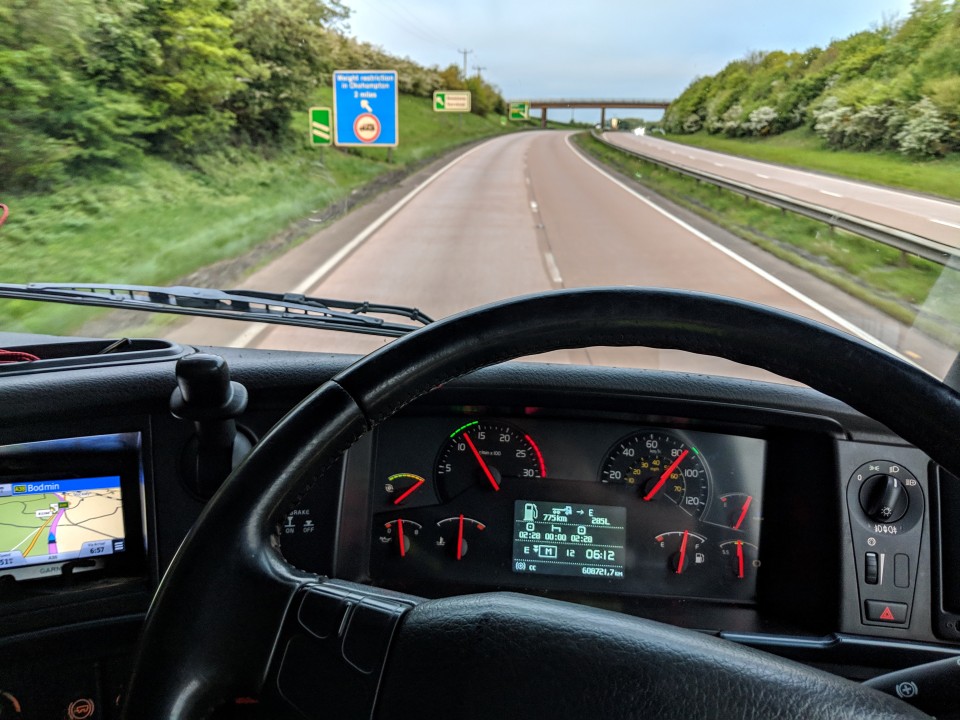
Susie Jones
Comment être un conducteur de camion en bonne santé
Créée: 27/08/2024
•
Mise à jour : 27/08/2024
En tant que profession exigeante, la conduite de camions implique souvent de longues heures de travail, un mode de vie sédentaire et des périodes prolongées loin de la maison, ce qui peut souvent nuire à la santé de nombreux conducteurs.
Des habitudes malsaines telles que la consommation de fast-food, le manque d'activité physique et des habitudes de sommeil perturbées peuvent entraîner des complications potentielles pour la santé à l'avenir. Mais comment rester en forme en tant que conducteur de camion ? C'est plus facile à dire qu'à faire, mais nous avons compilé une liste de conseils pour vous aider à rester au top de votre forme lorsque vous êtes sur la route.
Six conseils pour rester en bonne santé sur la route
1.Hydratation
Il s'agit d'un conseil simple et d'un produit que nous tenons souvent pour acquis, mais la plupart des problèmes de santé sont dus à la déshydratation. En buvant régulièrement des gorgées d'eau ou de squash tout au long de la journée, vous éliminerez les déchets métaboliques et les toxines de votre système et vous resterez plus énergique et plus alerte. Garder une bouteille d'eau rechargeable avec vous ne vous rappellera pas seulement de rester hydraté, mais c'est aussi meilleur pour l'environnement.
2.Régime alimentaire
La tentation de la restauration rapide après une longue journée est quelque chose que nous pouvons tous comprendre. Cependant, tout comme l'hydratation, votre alimentation joue un rôle important dans votre santé et dans la façon dont vous vous sentirez tout au long de la journée.
Il est recommandé aux chauffeurs routiers de manger trois à quatre fois par jour, soit deux repas et deux collations, soit deux repas et une collation. Essayez de suivre un programme de repas et de collations riches en oméga-3, en fer et en vitamine C, comme les légumes à feuilles vertes, le poisson et les fruits. Évitez les aliments et les boissons à consommation fréquente comme les pâtes, le pain, les boissons sucrées et les stimulants comme le café et les boissons énergisantes.
Consultez notre liste d'en-cas sains à conserver dans votre cabine :
Barres de céréales
Barres énergétiques
Maïs soufflé
Noix
Fruits secs
Chocolat noir
Outre l'achat d'aliments sains en déplacement, il peut parfois être plus sain et plus rentable de préparer ses repas. Le site [Frieghtech] (https://freightech.us/easy-meal-ideas-for-truck-drivers/) propose une fantastique sélection de recettes pour vous aider à maintenir une alimentation saine pendant votre travail.
3.Sleep
En raison de la nature du travail, il peut être difficile pour un conducteur de camion de dormir suffisamment et cela peut avoir des conséquences désastreuses pour tous ceux qui se trouvent sur la route.
Des conseils et des astuces simples, comme ceux qui suivent, peuvent vous aider à passer une bonne nuit de sommeil :
Créez un environnement dans la cabine qui donne l'impression d'être chez soi. Consultez notre article sur la façon de faire de votre cabine de camion une maison.
Gardez votre zone de sommeil dans l'obscurité
Une douche chaude : Utilisez notre page maps pour connaître les relais routiers qui proposent ce service.
Essayez quelques applications pour vous aider à dormir
Trouvez l'endroit idéal pour vous garer en limitant le bruit et les nuisances. Notre application intruck vous propose 5 000 emplacements pour poids lourds à travers l'Europe, tandis que notre équipe [SNAP Access and Security] (https://snapaccessandsecurity.com/) peut vous fournir des solutions de sécurité sur mesure, vous permettant de dormir sur vos deux oreilles en sachant que vous et votre camion êtes en sécurité.
4.Exercice
C'est l'un des conseils les plus difficiles à suivre sur la route, mais il est néanmoins important. De longues heures passées assis tout au long de la journée peuvent entraîner une mauvaise posture, des douleurs dorsales et des complications potentielles pour la santé. Après une longue journée au volant, il peut être tentant de s'asseoir et de se détendre, mais un petit quart d'heure d'activité comme la marche ou les étirements peut vous permettre de vous sentir rajeuni et moins stressé.
[HMD Trucking] (https://www.hmdtrucking.com/blog/truck-driver-exercises-workout/) propose des exercices utiles adaptés aux chauffeurs routiers si vous souhaitez intégrer plusieurs types d'exercices physiques dans votre routine.
5.Vitamines
Il peut être difficile de prendre toutes les vitamines nécessaires lorsque l'on est sur la route à plein temps. Prendre une multivitamine chaque jour peut renforcer votre système immunitaire et vous aider à rester en bonne santé.
6.Santé mentale
Nous savons qu'il est important de prendre soin de sa santé physique sur la route, mais combien de temps les chauffeurs routiers consacrent-ils à leur santé mentale ?

L'organisation caritative Mind, spécialisée dans la santé mentale, a publié des statistiques révélant que 30 % des maladies professionnelles déclarées dans le secteur du transport et de la logistique sont dues à l'anxiété, à la solitude, au stress et à la dépression. L'association a également laissé entendre que ce chiffre pourrait être plus élevé, car la plupart des gens ne cherchent pas à obtenir l'aide dont ils ont besoin. En outre, 95 % des personnes en congé de maladie ne donneront pas la véritable raison de leur absence du travail si elle est liée à leur santé mentale.
Suivre les conseils et astuces ci-dessus peut avoir un effet positif sur votre santé mentale. En outre, il est important d'avoir des conversations ouvertes et honnêtes avec les autres chauffeurs routiers, les superviseurs ou les répartiteurs.
L'exercice peut-il faire de vous un meilleur conducteur ?
Non seulement un mode de vie sain permet d'améliorer la santé mentale, mais il est prouvé qu'il peut aussi faire de vous un meilleur conducteur. Une étude a montré que les conducteurs à qui l'on demandait de faire de l'exercice quotidiennement avaient plus de facilité à tourner la tête, étaient capables de faire pivoter leur corps plus loin et pouvaient monter dans leur voiture plus rapidement.
Quelle est la partie la plus difficile du métier de chauffeur routier ?
Les longues heures de travail semblent être l'un des aspects les plus difficiles du métier de chauffeur routier. Les camionneurs sont souvent confrontés à de longs kilomètres à parcourir et à des heures antisociales. Ces longues distances et ces heures antisociales peuvent conduire à un mode de vie malsain.

Le métier de chauffeur routier est-il mauvais pour la santé ?
En raison de leur mode de vie, les chauffeurs routiers sont statistiquement plus susceptibles d'avoir des problèmes de santé que les personnes exerçant d'autres carrières. Les camionneurs sont souvent confrontés à des obstacles tels que des espaces de travail exigus, des situations stressantes, des rythmes de sommeil inhabituels et le manque d'aliments nutritifs, qui ont tous une influence sur leur santé.
Le maintien d'un mode de vie sain en tant que conducteur de camion exige un effort conscient, mais les avantages qui en découlent en valent la peine. Les conseils ci-dessus vous permettront de prendre votre santé en main et d'améliorer votre bien-être. Gardez l'œil ouvert pour d'autres conseils et astuces de la part de SNAP.



